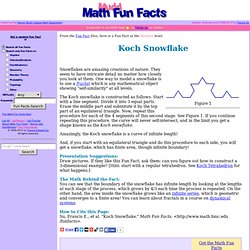

Koch Snowflake. Snowflakes are amazing creations of nature.

They seem to have intricate detail no matter how closely you look at them. One way to model a snowflake is to use a fractal which is any mathematical object showing "self-similarity" at all levels. The Koch snowflake is constructed as follows. Start with a line segment. Divide it into 3 equal parts. Amazingly, the Koch snowflake is a curve of infinite length! And, if you start with an equilateral triangle and do this procedure to each side, you will get a snowflake, which has finite area, though infinite boundary! Presentation Suggestions: Draw pictures. The Math Behind the Fact: You can see that the boundary of the snowflake has infinite length by looking at the lengths at each stage of the process, which grows by 4/3 each time the process is repeated.
How to Cite this Page: Su, Francis E., et al. Why is Learning Math so Important?: A Common Question by Students Learning Algebra, Geometry, and Trig. Every math teacher has heard at some point and probably often: What is the purpose of learning this math stuff? Almost every student in school dreads math classes because they see no real world applications, especially in algebra, geometry, trigonometry, and calculus. The simple answer to why learn math and other similar math questions – computers.
For example the animation industry has become a teacher’s friend; animation uses computers which rely heavily on the application of advanced mathematics. Computer animation programmers must know algebra, geometry, calculus, and trigonometry. Without extensive knowledge of math applications in animation, movies would not have visually rich environments and characters that we see today. Pixar, one of the leaders in movie computer animation, uses powerful supercomputers to perform geometric, algebraic, and calculus-based calculations to animate Pixar’s movie characters.
High School Math Classes Computer-Based Animation. My issues with Understanding by Design (UbD) » Mathematics for Teaching. Everybody is jumping into this new education bandwagon like it is something that is new indeed.

Here are some issues I want to raise about UbD. I am quoting Wikipedia in this post but this is also how UbD is explained in other sites. Understanding by Design, or UbD, is an increasingly popular tool for educational planning focused on “teaching for understanding”. Is not teaching for understanding been the focus of all curricular reforms, then and now? No curriculum reformer wants to be caught in the company of rote learning, never mind that it’s how curricula are implemented, regardless of its form, kind and substance in many classes.
UbD expands on “six facets of understanding”, which include students being able to explain, interpret, apply, have perspective, empathize, and have self-knowledge. I wonder which of these facets has not been a part of what it means to understand then. Back in college we attribute it to Ausubel who promoted the idea of using advance organizers. More. Dan Meyer: Math class needs a makeover. Function Matching. Free Calculus Tutorials and Problems. A+ Click Math Skill Tests and Problems for Grade K-1 K-12. Highmath.haifa.ac.il/images/data2/pitzuah/Faster_higher_stronger/faster.pdf.